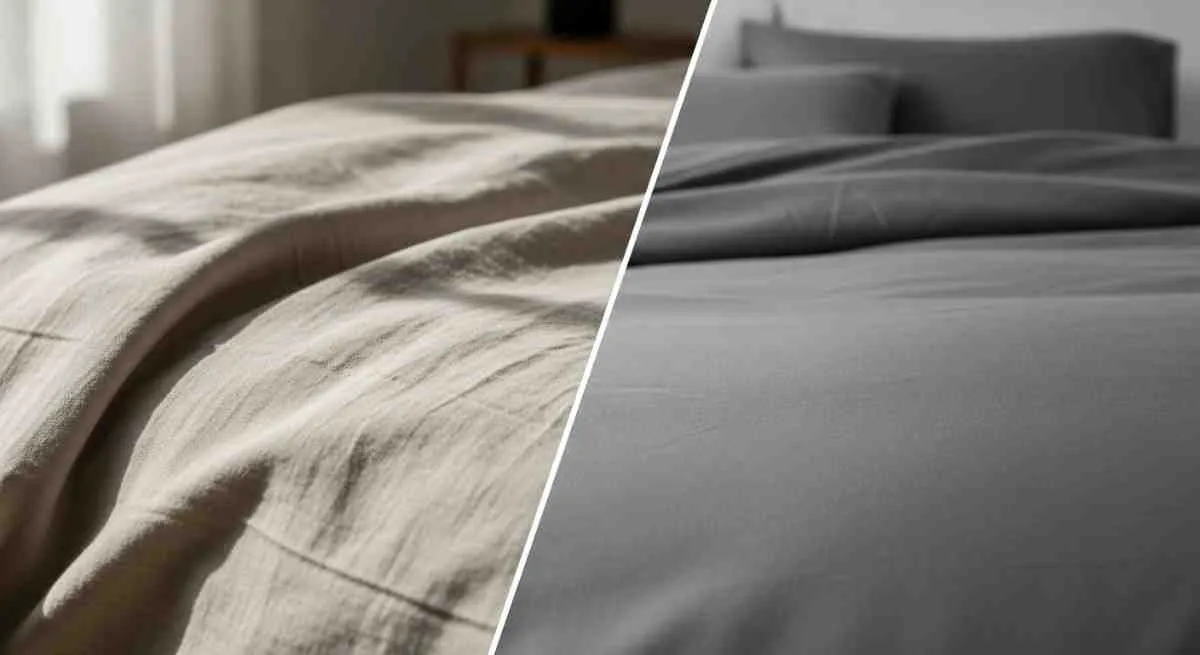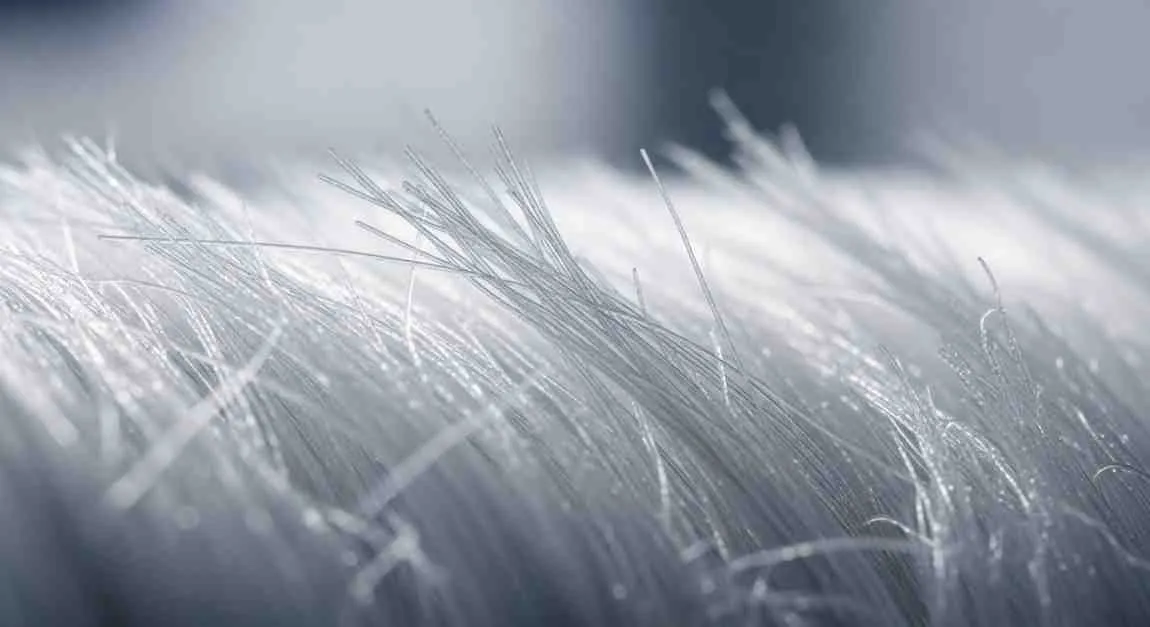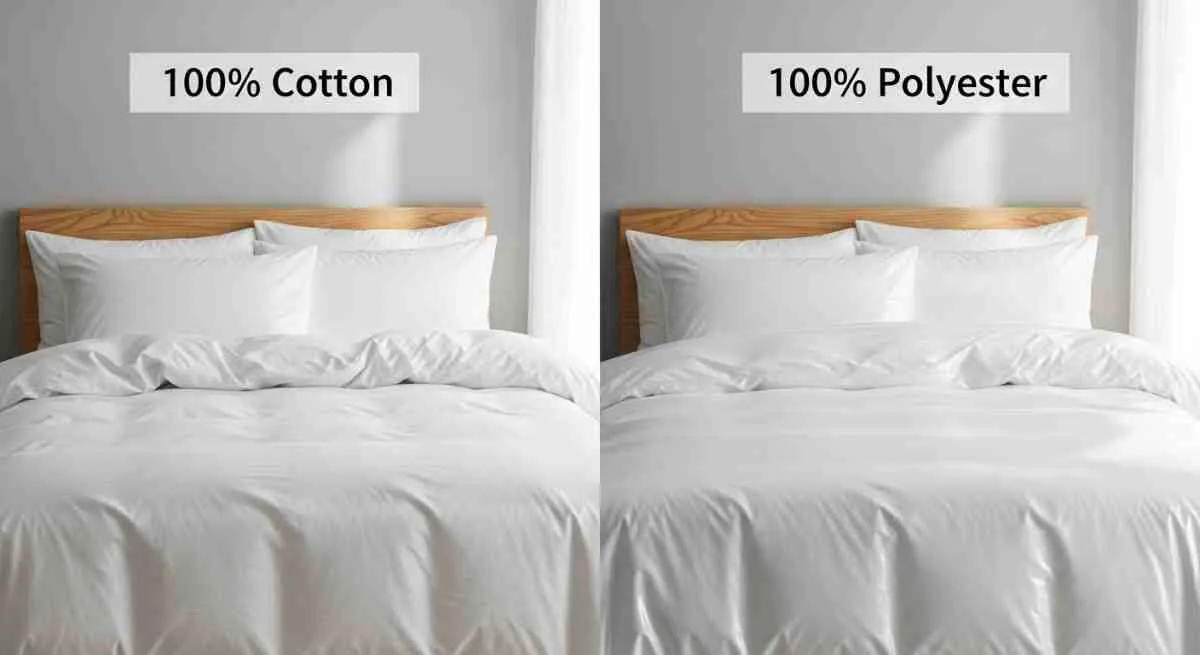Introduction
You’re standing in the bedding aisle, comparing price tags, and notice that polyester sheets cost a fraction of what cotton or linen bedding does. The polyester set promises wrinkle-resistance, durability, and easy care—all appealing features. But then a nagging question enters your mind: is polyester bedding bad for you? With growing awareness about the chemicals in household products, skin sensitivities, and environmental concerns, it’s natural to wonder whether the sheets you sleep on every night could be affecting your health.
Polyester bedding dominates the affordable bedding market, found in hotel chains, college dorms, and millions of homes worldwide. Its popularity stems from undeniable practical advantages: low cost, resistance to wrinkles and fading, and exceptional durability. However, beneath these conveniences lie legitimate concerns about polyester bedding safety, from chemical treatments and poor breathability to potential skin irritation and exposure to microplastics. The question isn’t simply whether polyester is “bad”—it’s understanding the specific health risks, who’s most vulnerable, and whether those risks matter for your individual situation.
The reality is more nuanced than simple yes-or-no answers. Polyester bedding affects different people differently. While some sleepers experience no issues whatsoever, others report side effects of polyester fabric including night sweats, skin irritation, allergic reactions, and respiratory discomfort. Scientific research reveals concerns about chemical additives, reduced breathability leading to sleep disruption, and environmental impacts that ultimately circle back to human health. Understanding these factors helps you make an informed decision based on your unique health profile, sensitivity levels, and priorities.
In this comprehensive guide, you’ll discover exactly what polyester bedding is made from, how manufacturing processes introduce potential health concerns, what scientific research reveals about synthetic bedding materials, and who should consider avoiding polyester sheets altogether. We’ll compare polyester vs cotton bedding and other natural alternatives, examine real-world experiences from people who’ve switched away from synthetic fabrics, and provide evidence-based recommendations for choosing safe bedding alternatives that promote both health and quality sleep. Whether you’re dealing with allergies, sensitive skin, or simply want to make healthier choices for your bedroom, you’ll gain the knowledge to sleep soundly—literally and figuratively.
What Is Polyester Bedding and How Is It Made?
Before assessing health impacts, let’s understand what polyester actually is and how it transforms from petroleum into your bedsheets.

The Science Behind Polyester Fabric
Chemical Composition:
Polyester is a synthetic fiber derived from petroleum-based chemicals:
Manufacturing Process:
Step 1: Raw Materials
- Primary ingredient: Crude oil or natural gas
- Refined into purified terephthalic acid (PTA)
- Combined with ethylene glycol
- Creates the basic polymer chain
Step 2: Polymerization
- Chemical reaction at high temperatures (300-500°F)
- Molecules link together forming long chains
- Creates polyethylene terephthalate (PET)
- Same material used in plastic bottles
Step 3: Fiber Production
- Melted polymer extruded through spinnerets
- Creates continuous filaments
- Cooled and stretched to desired strength
- Wound onto spools for textile manufacturing
Step 4: Textile Conversion
- Fibers woven or knit into fabric
- Chemical treatments applied (more on this below)
- Dyed using synthetic dyes
- Finished into bedding products
What This Means for Your Health:
The petroleum origin and chemical processing introduce several concerns:
- Residual chemicals may remain in finished fabric
- Manufacturing creates synthetic material foreign to human biology
- Unlike natural fibers, body doesn’t recognize or interact well with synthetic polymers
- Chemical treatments add another layer of potential exposure
Chemical Treatments Applied to Polyester Bedding
Common Fabric Finishes:
Polyester bedding typically undergoes multiple chemical treatments:
Anti-Wrinkle Treatments:
- Formaldehyde-based resins create permanent press finish
- Prevents wrinkles but releases formaldehyde gas
- Known respiratory irritant and carcinogen
- Can cause skin sensitization
Flame Retardants:
- Required by regulations for certain bedding types
- Chemicals include polybrominated diphenyl ethers (PBDEs)
- Known endocrine disruptors
- Can leach out over time with use and washing
Antimicrobial Treatments:
- Silver nanoparticles or triclosan commonly used
- Prevents odor and bacterial growth
- Environmental concerns about antibiotic resistance
- Potential skin and health effects under study
Stain-Resistant Coatings:
- Perfluorinated chemicals (PFCs) in some products
- Creates water and stain repellency
- “Forever chemicals” that accumulate in body
- Linked to various health concerns
Dyes and Colors:
- Synthetic dyes (azo dyes common)
- Some contain heavy metals
- Can cause allergic reactions in sensitive individuals
- Darker colors often have more chemical content
Important Note:
Not all polyester bedding contains all these treatments, but most contain several. Budget bedding tends to have more chemical treatments to achieve desired properties cheaply.
Types of Polyester Bedding Products
Common Polyester Bedding Items:
100% Polyester:
- Sheets, pillowcases, comforters
- Cheapest option
- Maximum synthetic exposure
- Most breathability concerns
Polyester Blends:
- Poly-cotton blends (50/50 or 60/40 common)
- Combines polyester durability with cotton comfort
- Reduced but not eliminated health concerns
- More breathable than 100% polyester
Microfiber (Polyester Variant):
- Ultra-fine polyester fibers
- Soft, dense weave
- Marketed as luxury alternative
- Same base material concerns as standard polyester
Polyester Fill:
- Comforter and pillow stuffing
- Less direct skin contact than sheets
- Can trap heat and moisture
- May off-gas chemicals
Health Risks and Concerns About Polyester Bedding
Let’s examine the specific ways polyester bedding may affect your health and sleep quality.
Poor Breathability and Sleep Disruption
The Breathability Problem:
How Natural vs. Synthetic Fibers Differ:
Natural fibers (cotton, linen, bamboo):
- Porous structure allows air circulation
- Absorbs moisture from skin
- Wicks sweat away from body
- Dries relatively quickly
- Regulates temperature naturally
Polyester:
- Non-porous synthetic structure
- Doesn’t absorb moisture effectively
- Traps heat against skin
- Creates humid microclimate
- Limited temperature regulation
Impact on Sleep Quality:
Night Sweats and Overheating:
Can polyester bedding make you sweat? Absolutely.
The mechanism:
- Your body cools itself through perspiration
- Evaporation of sweat provides cooling
- Polyester doesn’t absorb or wick moisture well
- Sweat stays on skin creating humid layer
- Body continues producing more sweat
- Cycle creates overheating and discomfort
Consequences:
- Frequent nighttime wakings
- Difficulty falling asleep
- Reduced deep sleep stages
- Morning grogginess despite adequate time in bed
- Sheets feel damp or clammy
Scientific Evidence:
Research published in the Journal of Physiological Anthropology found:
- Sleeping on synthetic bedding increased skin temperature
- Subjects experienced more sleep disturbances
- Natural fiber bedding promoted better sleep quality
- Temperature regulation directly impacts sleep architecture
Who’s Most Affected:
- Menopausal women experiencing hot flashes
- People with hyperhidrosis (excessive sweating)
- Hot sleepers naturally
- Those in warm climates
- Anyone with temperature regulation issues
Chemical Exposure and Off-Gassing
What Is Off-Gassing?
The Phenomenon:
Off-gassing occurs when volatile organic compounds (VOCs) release from synthetic materials:
In New Polyester Bedding:
- Fresh from packaging, bedding releases chemical vapors
- You may notice “new fabric” smell
- This smell IS chemicals you’re inhaling
- Continues at lower levels for weeks or months
Chemicals That May Off-Gas:
Formaldehyde:
- Used in permanent press finishes
- Classified as carcinogen by WHO
- Causes respiratory irritation, headaches
- Linked to allergies and asthma triggers
Antimony Trioxide:
- Catalyst used in polyester production
- Heavy metal with toxic properties
- Can be absorbed through skin
- Long-term effects unclear
Phthalates:
- Plasticizers sometimes used
- Endocrine disruptors
- Linked to reproductive health concerns
- Particularly concerning for children
Synthetic Dyes:
- Azo dyes may break down into carcinogenic compounds
- Can cause skin sensitization
- Some contain heavy metals
- Darker colors often worse
Health Effects of Exposure:
Short-term effects:
- Headaches upon waking
- Respiratory irritation
- Eye irritation
- Nausea in sensitive individuals
- Allergic reactions
Long-term concerns:
- Cumulative chemical exposure
- Hormone disruption potential
- Respiratory sensitization
- Unknown effects of chronic low-level exposure
Vulnerable Populations:
- Infants and children (developing bodies)
- Pregnant women
- People with chemical sensitivities
- Those with respiratory conditions
- Elderly individuals
Skin Irritation and Allergic Reactions
Does Polyester Bedding Cause Skin Irritation?
Yes, for many people, polyester bedding can trigger or worsen skin issues.
Mechanisms of Irritation:
Direct Contact Dermatitis:
- Polyester’s synthetic structure can irritate sensitive skin
- Lacks natural moisture of organic fibers
- Can create friction against skin
- Chemical residues contact skin for 7-9 hours nightly
Moisture Trapping:
- Sweat accumulates on skin
- Creates warm, moist environment
- Promotes bacterial growth
- Can worsen acne, eczema, fungal conditions
Chemical Reactions:
- Formaldehyde in finish causes reactions
- Dyes trigger allergic responses
- Antimicrobial treatments can irritate
- Multiple chemical exposures compound effects
Common Skin Complaints:
User-Reported Issues:
- Rashes: Red, itchy patches where skin contacts sheets
- Acne flares: Back, chest, face breakouts worsen
- Eczema triggers: Existing eczema becomes more inflamed
- Itching: Generalized itching without visible rash
- Dryness: Paradoxically, polyester can dry skin
- Fungal infections: Yeast overgrowth in warm, moist conditions
Research Evidence:
Studies on textile dermatitis show:
- Formaldehyde in fabrics common cause of allergic contact dermatitis
- Synthetic fibers associated with increased skin reactions vs. natural fibers
- People with existing skin sensitivities at higher risk
- Children’s sensitive skin particularly vulnerable

Respiratory Issues and Indoor Air Quality
Breathing While You Sleep:
How Bedding Affects Air Quality:
You spend 7-9 hours with your face inches from your bedding:
Chemical Inhalation:
- Off-gassing continues throughout night
- Breathing zone concentration higher than room air
- Repeated exposure night after night
- Cumulative effect over months and years
Dust and Particle Concerns:
Microplastic Shedding:
Recent research reveals polyester bedding releases microplastic fibers:
The Issue:
- Polyester sheds microscopic fibers with friction and washing
- These particles become airborne
- Inhaled during sleep
- Long-term health effects unknown but concerning
Studies Show:
- Synthetic bedding sheds significantly more particles than natural fibers
- Microplastics found in human lungs
- Connection to respiratory inflammation
- Children and elderly at higher risk
Respiratory Symptoms:
User Reports:
- Morning congestion or stuffiness
- Nighttime coughing
- Worsened asthma symptoms
- Sinus irritation
- Throat dryness
Exacerbation of Existing Conditions:
Polyester bedding may worsen:
- Asthma (chemical triggers)
- Allergies (dust mite habitat from moisture retention)
- COPD (irritant exposure)
- Chemical sensitivities
- Multiple Chemical Sensitivity (MCS)
Environmental Toxins and Microplastic Exposure
The Microplastics Problem:
What Are Microplastics?
Tiny plastic particles less than 5mm:
From Polyester Bedding:
- Released during washing (thousands of fibers per load)
- Shed during use from friction
- Become airborne in bedroom
- Enter water systems via laundry
- Eventually enter food chain
Human Health Concerns:
Emerging Research Shows:
- Microplastics accumulate in human tissues
- Found in blood, lungs, placentas
- Act as vectors for other chemicals
- Potential inflammatory responses
- Long-term effects still being studied
Your Nightly Exposure:
Sleeping on polyester means:
- Direct inhalation of shed fibers
- Skin contact with particles
- Ingestion through hand-to-mouth contact
- 2,000+ hours per year of exposure
Broader Environmental Impact:
While focused on personal health, environmental factors circle back:
Water Pollution:
- Washing polyester releases fibers into water
- Municipal treatment doesn’t remove all microplastics
- Returns to drinking water supply
- Bioaccumulates in fish and seafood
The Health Connection:
- What pollutes environment eventually affects human health
- Choosing polyester contributes to cycle
- Natural alternatives reduce both personal and environmental exposure
Comparing Polyester to Natural Bedding Alternatives
Understanding polyester vs cotton bedding and other natural options helps contextualize the health concerns.

Polyester vs. Cotton Bedding
Cotton: The Traditional Natural Fiber
Advantages of Cotton:
Health Benefits:
- Natural, biodegradable fiber
- Excellent breathability
- Superior moisture absorption (25x its weight)
- Hypoallergenic (especially organic cotton)
- No synthetic chemical treatments (organic varieties)
- Softer on sensitive skin
Sleep Quality:
- Temperature regulating
- Reduces night sweats
- More comfortable in various climates
- Naturally antibacterial properties
Drawbacks of Cotton:
- More expensive than polyester
- Wrinkles more easily
- May shrink if not pre-shrunk
- Requires more care (ironing for crisp look)
- Wears out faster than polyester
Conventional vs. Organic Cotton:
Conventional cotton concerns:
- Heavily pesticide-treated crop
- May have chemical residues
- Bleaching and dye processes
- Still better than polyester generally
Organic cotton benefits:
- No synthetic pesticides
- No harmful chemicals in processing
- GOTS certification ensures standards
- Best choice for health-conscious consumers
- Worth the premium for sensitive individuals
Polyester vs. Bamboo Bedding
Bamboo: The Eco-Friendly Alternative
Bamboo Fabric Properties:
Health Advantages:
- Naturally antimicrobial
- Highly breathable
- Excellent moisture-wicking
- Softer than cotton
- Hypoallergenic
- Temperature regulating
Sustainability:
- Fast-growing renewable resource
- Requires minimal water
- No pesticides needed
- Biodegradable
Important Caveat:
Processing Matters:
- Bamboo viscose/rayon: Chemical-intensive process (less eco-friendly)
- Bamboo linen: Mechanical processing (truly sustainable)
- Check manufacturing method before purchasing
- Still generally better than polyester even with chemical processing
Considerations:
- More expensive than cotton
- Can be delicate requiring gentle care
- Quality varies significantly by brand
- Best choice for hot sleepers
Polyester vs. Linen Bedding
Linen: The Premium Natural Option
Flax-Derived Linen:
Health Benefits:
- Exceptionally breathable
- Strongest natural fiber
- Naturally moisture-wicking
- Antimicrobial properties
- Hypoallergenic
- Improves with age
Sleep Experience:
- Stays cool in summer
- Insulating in winter
- Crisp, textured feel
- Gets softer with washing
- Reduces allergen buildup
Drawbacks:
- Most expensive option
- Textured feel not for everyone
- Wrinkles easily (part of the aesthetic)
- Limited color options
- Requires investment mindset
Best For:
- Hot sleepers
- Allergy sufferers
- Those prioritizing longevity
- Eco-conscious consumers
- People valuing natural aesthetics
Comparison Table: Bedding Materials
| Feature | Polyester | Cotton | Bamboo | Linen |
|---|---|---|---|---|
| Breathability | Poor | Excellent | Excellent | Superior |
| Moisture Wicking | Poor | Good | Excellent | Excellent |
| Chemical Exposure | High risk | Low (organic) | Low-Moderate | Very Low |
| Skin Sensitivity | Higher risk | Low risk | Very low risk | Low risk |
| Durability | Very High | Moderate | Moderate | Very High |
| Cost | Low | Moderate | Moderate-High | High |
| Care Required | Low | Moderate | Moderate | Low-Moderate |
| Environmental Impact | Very High | Moderate-High | Low | Very Low |
| Best For | Budget, durability | General use | Hot sleepers | Luxury, longevity |
Who Should Avoid Polyester Bedding?
Certain groups face higher risks from synthetic bedding materials.

People with Sensitive Skin Conditions
If You Have These Conditions, Avoid Polyester:
Eczema (Atopic Dermatitis):
- Polyester’s rough texture irritates inflamed skin
- Poor moisture management worsens condition
- Chemical treatments trigger flares
- Natural fibers significantly better
Psoriasis:
- Friction from polyester aggravates plaques
- Heat retention worsens symptoms
- Breathable natural fibers recommended
Contact Dermatitis:
- Formaldehyde and dyes common triggers
- Synthetic fabrics increase reaction risk
- Hypoallergenic natural alternatives essential
Acne-Prone Skin:
- Polyester traps oils and bacteria
- Poor breathability creates environment for breakouts
- Natural antimicrobial fabrics (cotton, bamboo) better
General Sensitive Skin:
- Any history of fabric irritation
- Reactions to synthetic clothing
- Chemical sensitivities
- Preference for gentle materials
Those with Respiratory Conditions
Asthma and Allergies:
Why Polyester Is Problematic:
- Chemical off-gassing triggers respiratory symptoms
- Moisture retention promotes dust mite growth
- Microplastic particles irritate airways
- Poor air circulation concentrates irritants
Better Choices:
- Organic cotton (no chemical triggers)
- Bamboo (naturally antimicrobial)
- Eucalyptus/Tencel (hypoallergenic)
- Always use allergen-proof covers
COPD and Chronic Respiratory Issues:
- Minimize all chemical exposures
- Avoid synthetic off-gassing
- Choose natural, breathable materials
- Consider air purifiers in bedroom
Chemical-Sensitive Individuals
Multiple Chemical Sensitivity (MCS):
People with MCS experience symptoms from low-level chemical exposure:
Polyester Bedding Triggers:
- Formaldehyde from finishes
- VOCs from synthetic materials
- Dye chemicals
- Antimicrobial treatments
- Off-gassing from new products
Symptoms Include:
- Headaches and migraines
- Fatigue and brain fog
- Respiratory distress
- Nausea
- Skin reactions
- Sleep disturbances
Safest Bedding Choices:
- Organic cotton (GOTS certified)
- Linen (naturally chemical-free)
- Minimal processing
- Natural, undyed fabrics when possible
- Air out new bedding extensively before use
Pregnant Women and Infants
Vulnerable Developing Systems:
Pregnancy Concerns:
- Hormonal changes increase sensitivity
- Fetal development vulnerable to chemicals
- Endocrine disruptors particularly concerning
- Heat intolerance common (polyester worsens)
Recommendations:
- Switch to organic natural fibers
- Avoid flame retardants
- Choose breathable materials
- Eliminate unnecessary chemical exposures
Infants and Children:
Why Children Face Higher Risks:
- Developing immune and nervous systems
- Higher exposure relative to body weight
- More time in bed (12-14 hours for babies)
- More sensitive skin
- Cannot communicate discomfort
Safe Sleep Environment:
- Organic cotton sheets essential
- Avoid polyester crib bedding
- Chemical-free mattress protectors
- Natural, breathable materials only
- No flame retardant treatments if legally permissible
Hot Sleepers and Those in Warm Climates
Temperature Regulation Challenges:
Polyester Worsens Heat Issues:
- Traps body heat
- Doesn’t wick moisture
- Creates muggy microclimate
- Prevents natural cooling
Who’s Affected:
- Natural hot sleepers
- Menopausal women (hot flashes)
- People in tropical or hot climates
- Those without air conditioning
- Anyone with overheating issues
Better Alternatives:
- Linen (coolest option)
- Bamboo (excellent moisture-wicking)
- Lightweight cotton percale
- Temperature-regulating natural materials
Real-World Experiences: Case Studies
Let’s examine actual experiences from people who’ve dealt with polyester bedding issues.
Case Study 1: Chronic Night Sweats Resolved
Profile:
- 45-year-old woman
- Experiencing perimenopause
- Waking 3-4 times nightly drenched in sweat
- Using polyester-microfiber sheets (purchased for softness)
The Problem:
“I thought my night sweats were entirely hormonal. I’d wake up multiple times soaked, having to change my pajamas. My doctor suggested it was just menopause and I’d have to deal with it. The polyester sheets felt soft initially, but I noticed they always felt slightly damp and warm.”
The Change:
Switched to 100% linen sheets based on a friend’s recommendation.
The Results:
“The difference was dramatic and immediate. The first night on linen, I slept through with only one minor hot flash. The linen absorbed moisture instead of trapping it against my skin. Yes, I still have hot flashes—that’s hormonal—but the bedding no longer makes it worse. I went from 3-4 soaking episodes per night to maybe one mild one. My sleep quality improved enormously. I only wish I’d made the switch years earlier.”
Key Lesson: Fabric choice significantly impacts symptoms even when root cause is medical. Natural, breathable materials can dramatically reduce symptom severity.

Case Study 2: Unexplained Skin Rash Mystery Solved
Profile:
- 32-year-old man
- Developed red, itchy rash on back, chest, and face
- No history of allergies or skin issues
- Rash appeared suddenly three weeks after buying new bedding
The Puzzle:
“The rash started gradually—some itching, then red patches that wouldn’t go away. I saw a dermatologist who prescribed steroid cream. It would improve slightly, then worsen again. We tried eliminating foods, changing laundry detergent, even got rid of our cat temporarily. Nothing worked consistently.”
The Connection:
After months of frustration, noticed the rash appeared three weeks after purchasing new polyester-blend sheets (60% polyester, 40% cotton).
The Experiment:
“I switched back to my old 100% cotton sheets to test the theory. Within four days, the itching decreased. Within two weeks, the rash was 80% improved. I waited another month, then tried the polyester sheets again for one night—the itching returned by morning.”
The Diagnosis:
Likely contact dermatitis from formaldehyde or dyes in the polyester bedding.
Resolution:
“I now use only 100% organic cotton bedding. The rash completely cleared and hasn’t returned in over a year. All that time, money, and discomfort from something as simple as my sheets. I had no idea fabric could cause such a severe reaction.”
Key Lesson: Chemical treatments in synthetic bedding can cause significant skin reactions even in people without previous sensitivities. Diagnosis is often missed because bedding isn’t considered as potential allergen source.
Case Study 3: Child’s Eczema Improvement
Profile:
- 5-year-old girl
- Moderate atopic dermatitis since infancy
- Using prescription creams with limited success
- Parents trying to minimize medication use
The Situation:
“Our daughter had patches of eczema that would flare constantly, especially on areas that contacted her bedding—back of legs, arms, face. We were using microfiber sheets because they felt soft and were affordable with kids who might have accidents.”
Pediatric Dermatologist Recommendation:
Switch to 100% organic cotton bedding, remove all synthetic materials from sleep environment, use allergen-proof mattress and pillow covers.
Implementation:
- Organic cotton sheets and pillowcases
- 100% cotton pajamas (no polyester)
- Allergen-proof covers
- Weekly hot-water washing
Results After 6 Weeks:
“The improvement was remarkable. Her eczema didn’t disappear—it’s a chronic condition—but the severity and frequency of flares decreased by approximately 60%. We still use prescription cream during bad flares, but need it maybe once a month instead of multiple times weekly. The areas that contact bedding improved most dramatically.”
Cost Consideration:
“Yes, organic cotton costs more upfront. But when we factored in reduced medication costs, fewer dermatologist visits, and most importantly our daughter’s comfort and sleep quality, it was absolutely worth every penny.”
Key Lesson: For children with eczema or other skin conditions, bedding material can significantly impact condition severity. Natural, organic fabrics should be first-line intervention before increasing medications.
Case Study 4: Environmental Sensitivities and Recovery
Profile:
- 38-year-old woman
- Developed Multiple Chemical Sensitivity after workplace mold exposure
- Reacting to many common products and materials
- Trying to create safe home environment
Chemical Triggers:
“After my illness, I reacted to everything—cleaning products, scented items, synthetic materials. I’d wake with headaches every morning but couldn’t figure out why. My bedroom should have been my safe space.”
The Investigation:
Working with an environmental medicine specialist:
- Removed all synthetic bedding
- Replaced polyester comforter and pillows
- Switched to organic cotton sheets
- Chose untreated, natural-colored fabrics
- Aired everything outdoors before use
The Results:
“The morning headaches stopped within a week. I didn’t realize the polyester bedding was off-gassing chemicals all night while my face was inches away. Removing synthetic materials from my bedroom made it genuinely restorative instead of another source of exposure. My sleep quality improved, morning symptoms decreased, and I could actually recover at night instead of continuing to be exposed.”
Ongoing Protocol:
- Only natural, organic fibers in bedroom
- Regular washing in hot water (chemical-free detergent)
- Minimalist approach (fewer items = fewer triggers)
- Careful vetting of any new items
Key Lesson: For chemically sensitive individuals, bedroom environment is critical. Eliminating synthetic materials, especially bedding with prolonged direct contact, can dramatically reduce symptoms and improve quality of life.
Pros and Cons: Balanced Perspective on Polyester Bedding
While we’ve focused on health concerns, let’s acknowledge both sides objectively.
Advantages of Polyester Bedding
Why Polyester Remains Popular:
Affordability:
- Significantly cheaper than natural alternatives
- Makes decent bedding accessible to more people
- Budget-friendly for students, temporary situations
- Low financial risk to try
Durability:
- Extremely strong fibers
- Resists tearing and pilling
- Maintains appearance longer than cotton
- Can last 5-10+ years with care
Easy Care:
- Wrinkle-resistant (minimal ironing)
- Stain-resistant treatments available
- Quick-drying
- Retains color well
- Doesn’t shrink
- Machine washable and dryable
Practical Applications:
- Guest rooms (infrequent use)
- Rental properties
- College dorms
- Short-term situations
- Temporary housing
Performance Features:
- Fade-resistant colors
- Moisture-resistant (double-edged sword)
- Lightweight
- Wide variety of colors and patterns
Disadvantages and Health Concerns
Why Health-Conscious Consumers Avoid Polyester:
Health Risks:
- Chemical exposure (formaldehyde, VOCs)
- Skin irritation and allergic reactions
- Poor breathability causing sleep disruption
- Night sweats and overheating
- Respiratory irritation potential
- Microplastic exposure
Comfort Issues:
- Doesn’t feel as natural against skin
- Less breathable than natural fibers
- Heat and moisture retention
- Can feel “plasticky” or synthetic
- Doesn’t improve with age like natural fibers
Environmental Concerns:
- Petroleum-based (non-renewable resource)
- Microplastic pollution
- Not biodegradable
- Contributes to plastic pollution in water
- Energy-intensive manufacturing
Long-Term Considerations:
- May promote dust mite growth (moisture retention)
- Loses softness over time
- Can pill with friction
- Static electricity buildup
- Doesn’t age gracefully
The Verdict: When Polyester Makes Sense
Polyester May Be Acceptable If:
✓ You have no sensitivities or health concerns
✓ You’re not a hot sleeper
✓ It’s for temporary or occasional use
✓ Budget absolutely doesn’t allow natural alternatives
✓ You’re using it in guest rooms with infrequent use
✓ You prioritize durability and ease of care above all else
Avoid Polyester If:
✗ You have sensitive skin or skin conditions
✗ You experience night sweats or overheat
✗ You have respiratory issues or allergies
✗ You have chemical sensitivities
✗ You’re buying for infants or children
✗ You’re pregnant
✗ You prioritize natural, non-toxic environment
✗ You can afford natural alternatives

Frequently Asked Questions
Is polyester bedding harmful?
Polyester bedding can be harmful for certain individuals, though not universally dangerous for everyone. The main health concerns include chemical exposure from manufacturing treatments (formaldehyde, dyes, flame retardants), poor breathability leading to sleep disruption and night sweats, potential skin irritation and allergic reactions, and microplastic shedding. People most at risk include those with sensitive skin, respiratory conditions, chemical sensitivities, pregnant women, and infants. However, individuals without these vulnerabilities may use polyester bedding without noticeable adverse effects. The key is understanding your personal risk factors and making informed choices based on your health profile.
Does polyester bedding cause skin irritation?
is polyester bedding safe? Yes, polyester bedding can cause skin irritation in many people, particularly those with sensitive skin or existing skin conditions. The irritation occurs through multiple mechanisms: direct friction from the synthetic fibers, chemical residues from treatments (especially formaldehyde in wrinkle-resistant finishes and synthetic dyes), and moisture trapping that creates an environment for bacterial growth and exacerbates conditions like eczema and acne. Common symptoms include red, itchy patches, worsened eczema flares, breakouts on face, back, and chest, and generalized itching without visible rash. If you notice skin issues that improve when away from your bed or worsen after changing bedding, polyester sensitivity should be considered.
Why is polyester considered bad for sleep?
Polyester is considered problematic for sleep primarily due to its poor breathability and moisture-wicking properties. Unlike natural fibers, polyester doesn’t absorb moisture effectively, causing sweat to remain on your skin and creating a humid, uncomfortable microclimate. This leads to overheating, night sweats, frequent wakings, and difficulty achieving deep, restorative sleep stages. Studies show that body temperature regulation is crucial for sleep quality, and polyester’s heat-trapping properties interfere with the natural cooling your body needs for optimal sleep. Additionally, chemical off-gassing from polyester can cause nighttime respiratory irritation, contributing to sleep disruption. Hot sleepers, menopausal women, and those in warm climates experience these issues most severely.
Is cotton better than polyester for bedding?
Yes, cotton is generally better than polyester for bedding from a health and comfort perspective. Cotton offers superior breathability, excellent moisture absorption (up to 25 times its weight in water), natural temperature regulation, hypoallergenic properties (especially organic cotton), and no synthetic chemical treatments in organic varieties. These properties translate to better sleep quality, reduced night sweats, lower



